Hybrid View
-
12-06-2008 08:13 PM #1
I was working on the rearend, but had to stop and finish painting a few parts. Since Mother Nature controls the temperature in my "paint booth", it has been a little too cold to paint. I saw a window in the weather, so I figured I had better take advantage of it.
There were a few more parts left to paint than I had thought, but I think I have them all done now. Maybe I can make some headway on final assembly.
As for the rearend, it turns out that it was a carrier bearing and not a pinion bearing going bad. I went ahead and changed all the bearings since I had bought a Raytec kit that had them all in it. I did go with the posi and also swapped in the 3.42 gears out of the Camaro rearend. I may not like the posi after I start driving it, but I'll never know for sure if I don't try it. I do appreciate all those that gave their opinions on whether to use it or not.
The 3.42's will lower my cruise RPM's a little, but I don't think they'll hurt my performance too bad. With the 3.06 first gear in the 700R4, acceleration should still be plenty quick. Might even help my gas mileage a little.
The swap went pretty good and I only had to change the pinion shim 3 times to get it where I think it needs to be. The pattern looked good so maybe it won't howl like a banshee!
I did use a solid pinion spacer and shim kit instead of a regular crush sleeve. I really liked how easy it was to use and it's supposed to help keep the rearend together when you're beating on it. I don't know about that, but I'd use it again just for the ease of setup.
I also swapped out the pinion yoke. The old unit had a rubber mounted balancer on it. It was probably on there to dampen some unwanted harmonic vibration in the S-10 driveline. I doubt my 12" driveshaft has anything close to the harmonics of the original driveshaft. Not only that, but that thing weighed right at 10 pounds! The one on the Camaro weighed just a little over 2 pounds. That was an easy way to shed 8 pounds of rotating weight and drop a little unsprung weight to boot. All good in my book! Besides, from a safety standpoint, I have no idea what kind of RPM's that thing was rated for. It has the potential to spin at crankshaft speed(or higher in OD) and if it let go, there would be big hunks of cast iron flying around right under my butt! Probably not very likely to happen, but you never know.
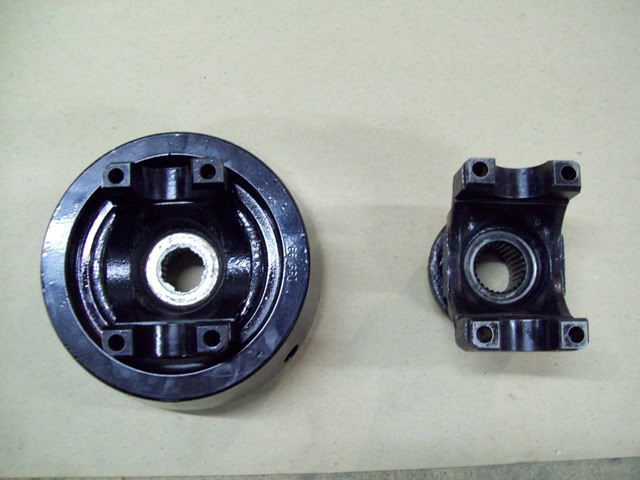
-
12-06-2008 08:35 PM #2
The trans was one of the things I had left to paint.
I also changed out the lockup pressure switch on the valve body. It is now wired to lock in 4th gear or I will be able to select lockup in 2nd, 3rd and 4th.
I had a chrome pan for it, but it turned out to be a piece of Chinese junk! The bolt holes were off just enough to prevent it from going on. I could have slotted them, but I didn't want to take a chance with leaks. I cleaned the old pan up and painted it silver. I also welded in a bung for a temp sensor. I don't know if I'm going to use it, but it'll make a good drain plug if nothing else.
The bolt holes were off just enough to prevent it from going on. I could have slotted them, but I didn't want to take a chance with leaks. I cleaned the old pan up and painted it silver. I also welded in a bung for a temp sensor. I don't know if I'm going to use it, but it'll make a good drain plug if nothing else.
I installed the dip stick too. It's a Lokar unit, but I had to fab a new mount. The original mount was going angle it up toward the headers. The new mount puts it vertical near the firewall.
I hope to get the shifter on next week.
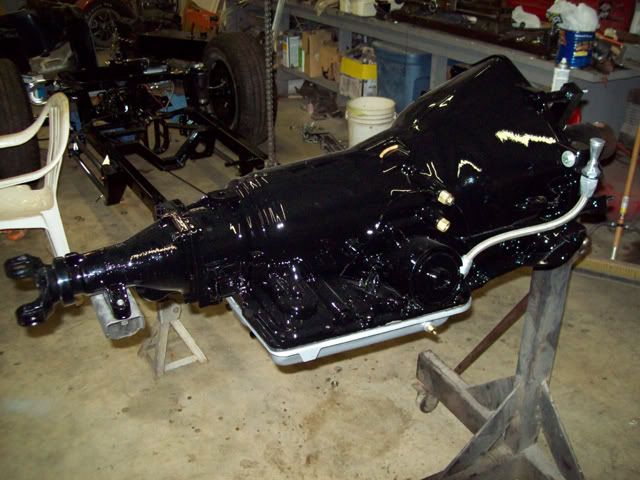
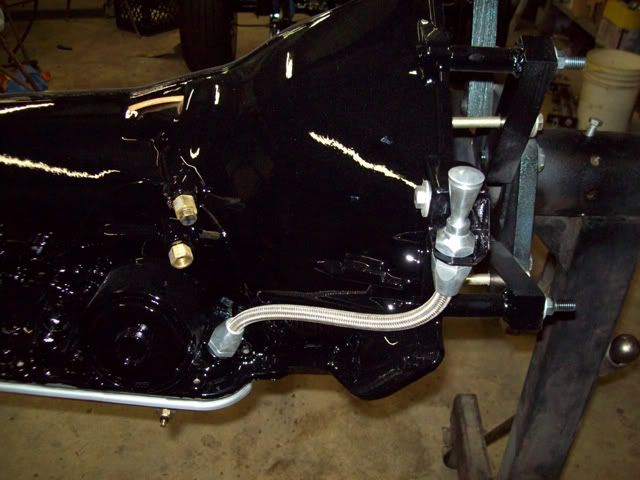
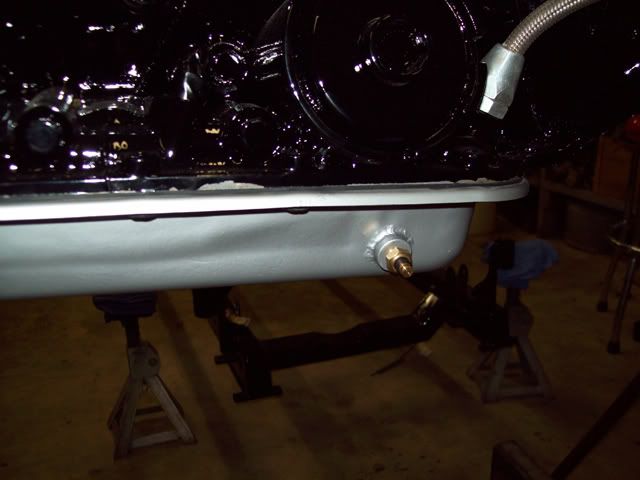
-
12-07-2008 05:45 PM #3
Now it time to talk about a little technical problem I created for myself.
Warning: This is very long post!!!(for me at least)
Anytime you make changes to a build after you're well along in the construction, you're subject to create problems and that's just what happened here. I do want to add that I'm not an engineer and this is just a long story about what I did to my car. I'm not going to tell you this is what you should do (only you can decide that).
I started this build with GM metric disc brakes on the front and S-10 drum brakes on the rear. Since these components were designed to work together by GM, they would have been a pretty good setup. The problem cropped up when I swapped the repro 39 Lincoln drum brakes on the front.
Now I had huge relatively low pressure 12" brakes designed to stop 2+ tons of Lincoln (with no booster) on the front and 9 1/2" brakes on the rear designed to work in a high pressure boosted disc brake system. The front wheel cylinders were 1 1/8" bore, the rears were 3/4" bore and the master cylinder was 1" bore. Throw in a pretty good difference in rubber size and it was obvious that I had a bad mismatch. I figured that with the boosted master cylinder and self-energizing drums front and rear, the brakes were going to be overly sensitive and the fronts were going to be locked up before the rears ever got enough line pressure to do anything meaningful.
My first thought was to swap to bigger drums on the rear. That would have easily solved the brake mismatch issue, but would have added a lot of unsprung weight to an already heavy rearend. T's don't have a good sprung/unsprung weight ratio anyhow and I didn't want to make it worse by adding more weight. Besides, the S-10 drums and other parts I had were in perfect shape. All I really needed were new wheel cylinders. So, I looked at other options.
I decided to do a little research on drum brake systems from back when they were pretty much the only game in town to see how they were setup from the factory. The NAPA website lists the bore sizes of brake parts, so I spent some time checking out brake specs for several cars and trucks from the 50's and 60's. I did notice a pattern (sort of) in the sizes of parts. I say "sort of" because there are always exceptions. The front wheel cylinders and master cylinders were generally the same or nearly the same bore. Manual brakes had slightly larger wheel cylinders on the front, while power brakes got pretty much the same size as the master. The rear cylinders were about 20% smaller (by area) on trucks and 10-15% smaller on cars.
Using my research as a guide, I looked for a better combination of parts. Since my master cylinder is 1" bore and has a booster, I looked for some 1" bore wheel cylinders for the front. A late 60's Buick 225 has 12" brakes (turns out that didn't really matter) and 1" wheel cylinders on the rear that matched the castings and port locations of the Lincoln brakes I was using. They were a direct bolt-in replacement and brought me in line with my research.
The rear wasn't quite as easy, though. The rear cylinders are of a much later design than the fronts and had a unique setup. The pistons and the extensions that push on the shoes are one piece. The only wheel cylinders I could find that were larger and had those pistons were from a 90's model Astro van. They were 7/8" bore. That's still almost 30% smaller than the fronts. It was time to go to plan B.
I found that an early 80's Caprice had 15/16" bores, the same port layout and bolt spacing, but of course the pistons were wrong and the machined locating boss was 1/8" too big. Hey, that's no problem since I have a lathe and I'm not afraid to use it!
I fabbed up some new steel pistons with the correct shape and size. I also turned the wheel cylinder boss down and pushed the shoulder back to get the center line of the bore back where it needed to be.
These new cylinders are 19% smaller than the fronts and that's a lot closer to my research. Not as good as I had hoped, but in the ballpark. The next size up would be 1", but I don't want to worry about locking up the rear wheels first on slick roads (or dry roads for that matter).
I could have left the 1 1/8" cylinders in the front and went with 1" cylinders in the rear (modified 85 Chevy truck), but I would have had to change the master cylinder to a 1 1/8" unit. That would have given me a 14% difference, but the master cylinder costs more than the wheel cylinders.
I'm going to leave it as it is for now and see how it works. I can always make changes later. Since the new rear cylinders have an area that is 36% larger than the old units, there's no doubt that these mods will improve the effectiveness of the rear brakes. The smaller front cylinders should make the front brakes less sensitive. The only problem will be if I created a premature lockup problem in the rear (that won't be good!). I'm not overly concerned about that because the difference in drum and tire sizes still has the rear brakes at a disadvantage. Time and testing will tell, but I'm moving on to other parts of this project for now.
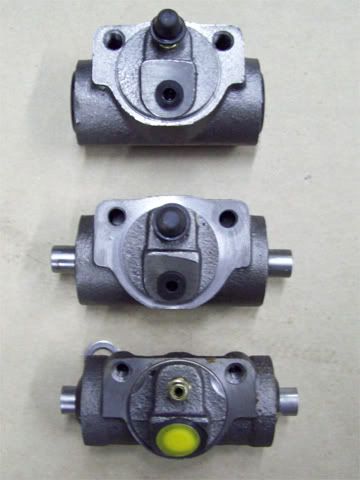
Top cylinder is the stock Caprice unit, bottom is the stock S-10 and the middle one is my new hybrid.

Just a little action shot of the lathe work.





 4Likes
4Likes

 LinkBack URL
LinkBack URL About LinkBacks
About LinkBacks Reply With Quote
Reply With Quote

Several years ago we did quite a good trip of USA, and on our trip we got to meet Mike and Christine Frade. We didn't stay long with them, but in that relatively short time we both gained a great...
We Lost a Good One